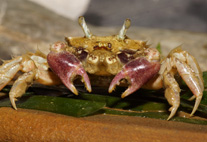Abstract
Sabellidae are among the most visible polychaetes of the hard substrate fouling communities and are colonizing new geographic areas. The fouling community was surveyed in 25 shallow coastal estuaries on the Atlantic and Pacific coasts of the United States with the specific goal of detecting non–indigenous species. During surveys in 2012 and 2014, specimens of Branchiomma coheni Tovar-Hernández and Knight-Jones, 2006 were found for the first time in Tampa Bay, Florida, occurring at the same marina site (27°53'7.58"N, 82°32'2.29"W) each year and suggesting it is established here. The species was not detected at other sites surveyed in the United States, and has not been reported from the eastern Atlantic or the Mediterranean basin. Type material of B. coheni, specimens from southern Gulf of California, and specimens from the Pacific coast of Mexico, were used to corroborate identification. The transfer of this species by ships via the Panama Canal is a probable mechanism of introduction, based on the current known distribution and shipping traffic patterns. This represents the first record of the species in the Atlantic Ocean. A worldwide update of the records of this species and a list of valid species of the genus Branchiomma with notes on introduced populations are provided, as well as recommendations for accurate identification and sampling.

